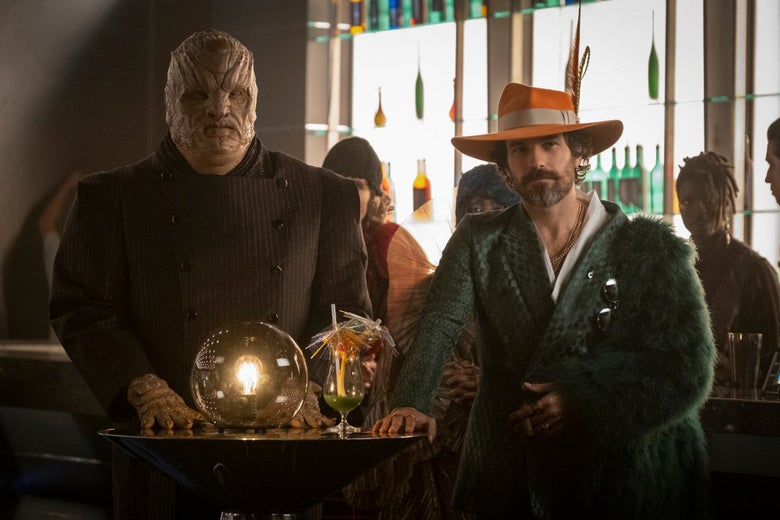
Dominic Burgess as Mr. Vup and Santiago Cabrera as Rios.
Trae Patton/CBS
The latest episode of Star Trek: Picard featured the return of one of the best parts of Star Trek, and no, I don’t mean Seven of Nine. In “Stardust City Rag,” Picard and his ragtag crew do cross paths with the iconic Voyager character on their quest to find Bruce Maddox, an expert on artificial life forms. But the return I’m referring to isn’t a reformed Borg but a delightful Trek trope: zany costumed personas.
“Stardust City Rag” is a heavy episode, filled with heartbreak, ethical dilemmas, and an unusually high level of violence for a Star Trek show. (There are multiple murders, all of them perpetrated by the heroes.) It’s also surprisingly funny. In order to carry out a hostage exchange for Maddox, the crew poses as seedy criminals with outrageous outfits. The ship’s pilot, Rios, puts on an emerald suit and fur, wears sunglasses indoors, and tops the ensemble off with a garishly plumed hat. Patrick Stewart seems to delight in his “appropriately sinister” costume, which features a jauntily perched beret, an eyepatch, and a comically exaggerated French accent. Picard thus far has been a relatively somber entry in the Trek canon, down to the contemporary-feeling jackets and sweaters the characters tend to wear, but at the sight of these goofy costumes, this episode instantly felt more like Trek to me than any previous Picard episodes did.
Putting on an alternate persona, whether for survival or fun, is a time-honored Trek tradition, one that extends back to the original series. With its pajama-like uniforms and bizarre aliens, Star Trek always had a floridly fantastic aesthetic, to the point where putting the characters in 20th century clothing to blend in was somehow even stranger. Sometimes, an entire episode was based around characters adopting such personas, as in “A Piece of the Action,” in which the crew visits a planet with a culture based on 1920s Chicago and find themselves forced to imitate gangsters, a task they come to relish. Other times, the personas might be a means to an end, with Kirk and Spock fumbling to fit in while time-traveling to New York City in 1930 or San Francisco in the 1980s while on vital missions.
Playing dress-up continued in subsequent franchise iterations, particularly with the advent of Holodecks, the virtual reality environments popularized in the ‘80s and ‘90s series . On The Next Generation, Data and Geordi could occasionally be found acting out Sherlock Holmes mysteries in full Holmesian regalia, while omnipotent Q never hesitated to throw Picard and company through time and space, including all the way back to Robin Hood’s Sherwood Forest in “Qpid.” Deep Space Nine and Voyager let its characters play pretend through the usual devices—including time travel and the goatee-ful Mirror universe—but it also took full advantage of the Holodeck: Adventures there ranged from Bashir and Garak playing James Bond (“Our Man Bashir”), to a heartwarming game of intercrew baseball (“Take Me Out to the Holosuite”), to the crew unwinding in an idyllic Irish village (“Fair Haven”), to Flash Gordon-inspired cosplay (“Bride of Chaotica”). Enterprise, too, had episodes such as “North Star,” where the crew has a cowboys-versus-space-travelers shootout on a Wild West-inspired planet.
It’s a pleasure to see this concept return in Picard, not just because it’s fun, but also because of a central tenet of Trek’s ethos. Despite what Picard has shown us so far, Star Trek in its heyday was rarely about grand schemes to save the galaxy. Rather, its focus was exploration, wherever that pursuit led, and the occasional silliness of that journey is a classic part of the franchise. Sure, exploration could involve confronting major threats and weighing ethical questions, but it could also involve situations where the unknown is less dangerous and more misunderstood, like the rock-like Horta, or downright silly, like the fuzzy, multiplying Tribbles—or even just a nuisance, like Q. Those encounters are no less worthwhile for lacking apocalyptic risk. Trek’s celebration is in the discovery of worlds, civilizations, species, technology, and even the self, based on the indefatigable belief that there is innate value in engaging with the unknown with intelligence and compassion. If that pursuit involves a little silliness, then that is simply a part of the journey. Sisko puts it well during the aforementioned baseball episode: “That’s what I love about this game. You never know what’s going to happen next. Every situation is different.”
Some recent iterations of the Trek franchise—J.J. Abrams’ reboot movies and the Discovery series come to mind—have shied away from the franchise’s more lighthearted aspects in favor of grittier stories set in the Trek universe(s). But while Star Trek has always had its share of action and gloom, too much of either risks overpowering the adventure and wonder that make the franchise special. By making time for a zany caper and balancing that silliness with the episode’s seriousness, Picard reflects a welcome celebration and understanding of Trek’s nature. If this is what Picard has in store, I hope it lives long and prospers—eyepatch and all.
from Slate Magazine https://ift.tt/2PIhGRF
via IFTTT
沒有留言:
張貼留言